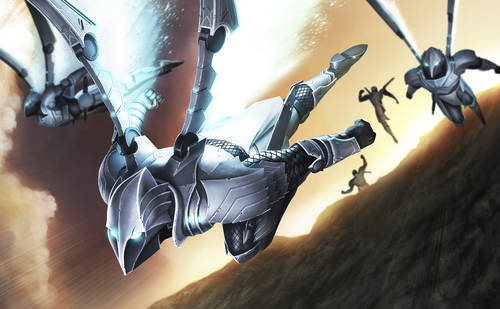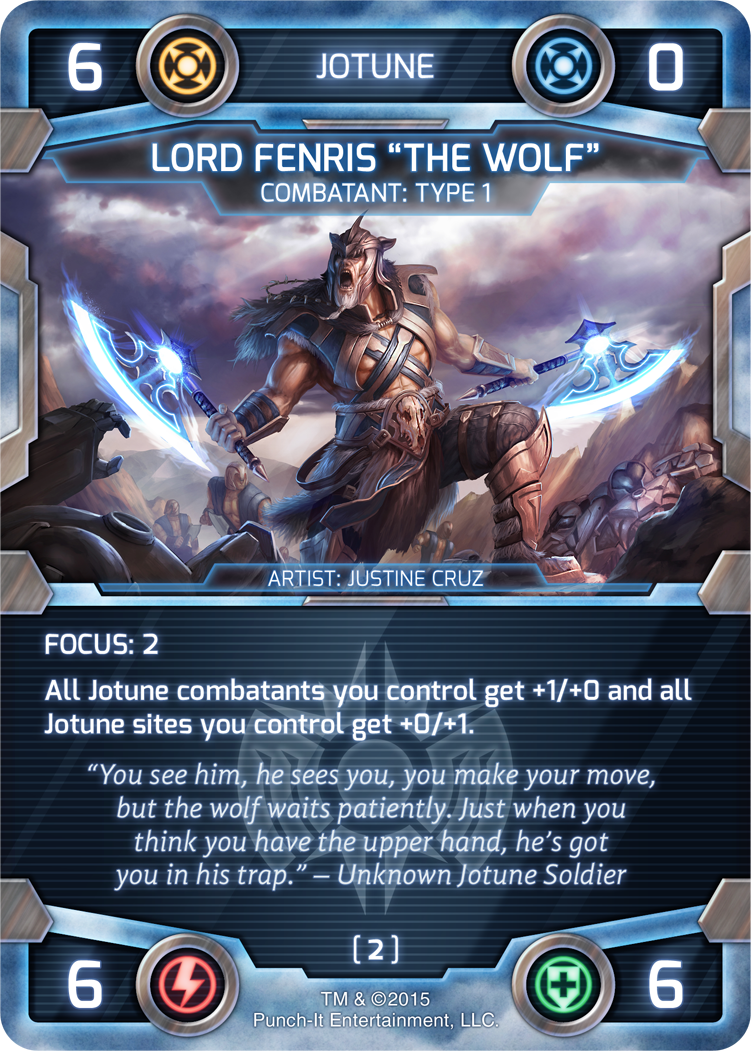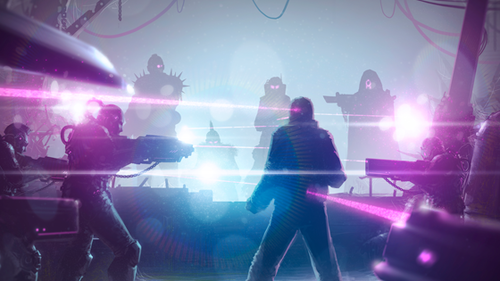
Overview
This is a card game obviously inspired by Magic the Gathering but with other mechanical leaning toward traditional RTS videogames such as Command & Conquer or Star Craft. You build one type of resource to generate another resource to ultimately cash out by playing combatants. Combatants are therefore actors that can attack the enemy base and potentially destroy sites, while also blocking attacks to prevent site damage. Players take turns attacking sites and trying to deal 25 damage to their opponent.
Components
I can’t quite tell what card stock this is due to not having ripped one yet. If I had to guess, it may be 280gsm and grey core. The card is almost transparent when a light is shone under it but they tried to make up for the cheap stock with a heavy gloss finish. For the price, I think a higher quality card stock should’ve been an absolute in the eyes of the designers. The print quality is overall good, if a bit dark in some areas. However, the game comes play-complete (max playsets of each card, plus some extras) which is a huge plus. Many times, you open one of these expandable card games (usually from Fantasy Flight) and do not get a whole play set of each card, causing you to buy more sets thus increasing the price point beyond what you expected.

UI/UX
The aesthetic of the card design is great and evokes the desired sci-fi theme. UI/UX does suffer a bit due to the heavy amount of text space, mostly taken up by flavor. It would be nice if the designers had remembered that card games primarily attract art collectors not text snippit collectors. Otherwise, it can be incredibly pleasing on the eyes when cards are all sprawled out in front of you. The 4-corners of the card convey the meat of the necessary information well, though I would’ve liked to have seen no spacial split between ATK/DEF as this can often cause memory problems (see Ashes: Phoenixborn). The art itself ranges from mediocre to truly great, with the vast majority being on the better end of the spectrum. The unique theme of each faction comes through well on each card, giving the game a feeling of an alive world with verisimilitude. I’m not fan of vertically symmetrical card frame design, but this works well enough that I can overlook the design choice. In the future, I hope Punch-It listens to player feedback and shrinks the unnecessary large portions of wasted space in their UI.

The Gameplay
While the game is pretty simple per the overview, I left out quite a bit of details. The resource flow works as follows: each turn you play any card in hand facedown as an “influence”. This resource is spent to play sites, which in-turn generate Sularium every turn, which is then spent to play combatants or pay ability costs. Influence has one other use, which is to meet the threshold condition to play a tactic card. Tactics work like Instants from Magic except you do not pay a cost, merely require enough influence to activate it. In addition, tactics can be activated from face-down in the influence row without being discarded! This makes them an ideal “mana-base” of sorts since they’re never dead and end up performing similar functions to Yugioh trap cards. This is a great mechanic and typically resulted in fun chains during the game. I can see this potentially being abusable, particularly with direct damage cards, since there’s no possible way to stop them in the base set and never a way to remove cards. Further adding to the crazy antics of tactics cards are the effects which let you flip them face-down on the influence row. This allows them to be reactivated at a future time.
While influence refreshes each turn, Sularium does not and must be generated from site cards. Sites are initially paid for by spending an amount of influence, but then immediately generate the permanent resource Sularium. Sites also tend to have abilities and powers (such as turning them sideways to make each of your opponent’s combatants -2 defense). Sites always have a defense value which determines how much damage they can sustain until they are destroyed but also sometimes an attack value which makes them formidable in their own right. There are two rows of sites a player can lay: front and back. Opponents without the FLIGHT ability cannot attack the back row, so it’s useful to place sites there initially, then have more defensive sites placed in front of them to keep the number ramp up. Players could also put special sites in the back to protect them. In addition, sites must be adjacent to other sites on the same row (but can be placed on either extreme side). This is so one of the attacker abilities can hit two sites simultaneously. Combat damage (not direct damage) in this game is all Trample. Every point of defense matters, not just the last one, despite damage being refreshed at the end of the turn. Overpowering a site or combatant typically results in the absolute best outcome—since spillover damage goes directly to a player. Sites also force the owner to suffer damage equal to their influence cost when destroyed, so later-game sites tend to be high risk, high reward.
Since Sularium does not empty from a player’s resource pool, it can be stored to pay for combatants and tactics costs later. This allows players to spend some early game time simply building up influence, sites, and storing sularium to drop their big combatants early. Players can of course sequence their cheaper combatants first if they are drawn. This aspect makes drawing a good opening hand much easier, since there’s no “use it or lose it” aspect to any of the resources. That’s a good thing, too because one of the weaknesses of this game tends to be the player with the better site-cost-curve in the opening hand will tend to have a better early game launch. This is an aspect I could see needing a bit of improvement through abilities that let you search for low-cost sites using cheap tactics cards. As it stands, it shouldn’t cause too much headache; in the first four games, we didn’t yet experience a loss due to drawing a bad site curve, though mulligans were frequent. The game is at least forgiving enough to give a full mulligan at no cost.

The two factions in the starter set (Jotune/blue and Synthien/red) are wildly out of whack balance-wise, favoring Jotune. I believe this problem occurs because most game designers significantly under-rate pure aggro decks. In a game like BFS where removal is incredibly weak, which is a refreshing change of pace, it does cause aggro to be a bit over-the-top. This can be remedied by having the Synthien player understand how to better leverage their powerful tactics cards to shut down the endless wave of Jotune fliers. Ultimately, the Synthien player has the most uphill battle even if it were the case that they were the stronger faction. The recommended starter decks add kerosene to this fire by essentially setting up Jotune with an all-FLIGHT rush deck and Synthien with a stall-and-wait OHKO.
Without any explanation as to how to use these in the rulebook, a Jotune player is probably going to overrun a new Synthien player since the Synthien won’t realize it’s best to be defensive and charge up enough Sularium to kill their opponent with Synthien Tactical Assault Beam (a Fireball-like tactic where you can deal X damage to any target, by spending permanent Sularium on X). If a Synthien player doesn’t magically know this, they will undoubtedly spend early Sularium on STAB, as their deck significantly lacks enough combatants for early attacking. The Synthien player may then have to rely on pure chance to draw another STAB for any hope of a win. In this way, the opening game will feel a bit swingy and I think it could’ve benefited from more blind play testers. This gap in playability seems to sink drastically if you also have the Jotune/Synthien expansion Blood Profit and Glory. This expansion’s excess combatants tend to raise Synthien to the same level as Jotune but it should be noted that aggro is still king here and Synthien doesn’t easily obtain FLIGHT.

Expansions
Currently, the game has one expansion—Blood Profit and Glory, for the red and blue factions (making them feel complete) that also includes more factionless mercenaries which I find incredibly useful. Some of these new cards are pretty significantly powerful but cost more to add to your deck. They’ve also decided to release keywords which just act as “tags” other cards can reference in expansions. I’m not sure why this was omitted from the base set and sad to say, it’s a bit too little too late by the time you get to the expansions. The only new characteristic added in Blood Profit and Glory is “Warrior” for Jotune-only, and there are only a couple of them. Punch-It has also released a green faction which I won’t spoil here. A yellow faction is currently in the works as of this publishing.

Conclusion
Overall, Battle for Sularia was an incredibly surprising romp through a “what if…” case: “what if Magic the Gathering were actually good?” and didn’t have a plethora of bad and outdated poker-inspired mechanics, Game of Chicken battle system, annoying mana system, and multi-color mush decks. It makes for a great two-player complete game and you would never need an expansion to get a deep tactical experience. Deck construction uses an interesting system of cost-per-card as well as a 60-card minimum, making for some interesting limitations that never felt choked and invoked the feeling of wargame army building in this regard. The game certainly has downsides: significant lack of a large enough card pool for long-term play, a slow release schedule, and drawing the correct ratio of cards (Sites/Combatants/Tactics) can be a significant limiter on your ability to do well during a game. If you want an original sci-fi world, there is a ton of flavor text to read and even more lore on the Punch-It website. Overall, I would say that the good outweighs the bad enough to get Battle for Sularia if you like dueling card games.

Leave a comment